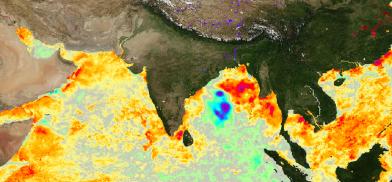Cyclones batter South Asia as Indian Ocean heats up
Nisarga, the first cyclone to have threatened Mumbai in more than 70 years, has left India’s financial capital largely unharmed after it made landfall in the nearby beach town of Alibaug on June 3

Nisarga, the first cyclone to have threatened Mumbai in more than 70 years, has left India’s financial capital largely unharmed after it made landfall in the nearby beach town of Alibaug on June 3. Gujarat and Maharashtra along India’s western coast have traditionally been more sheltered from cyclones than the country’s eastern coast. But this time unusually warm surface temperatures in the Indian Ocean resulted in a weather depression that rapidly intensified into a severe storm in the Arabian Sea, scientists said.
South Asia has been hit by two cyclones in as many weeks, with Cyclone Amphan ravaging parts of eastern India and Bangladesh on May 20. Such extreme weather events in close proximity have once again highlighted the impact climate change has in the region. Coming at a time when countries in South Asia are grappling with the Covid-19 crisis, this has only multiplied the plight of millions.
Such extreme weather events in the northern Indian Ocean are no longer exceptional. Severe cyclones are expected to increase in number and intensity on both the east and west coasts of the Indian subcontinent because of a rapidly warming Indian Ocean, climate scientists said.
“In the case of both the recent cyclones, Amphan and Nisarga, the anomalously warm ocean temperatures are giving them a major boost,” said Roxy Mathew Koll, climate scientist at the Indian Institute of Tropical Meteorology. Temperatures in the Bay of Bengal were between 30-33C when Cyclone Amphan formed in mid-May and surface temperatures over the Arabian Sea were 30-32C before the weather depression that evolved into Cyclone Nisarga. “Such high temperatures aid rapid intensification of cyclonic systems,” Koll said.
Climate connection
Climate change amplifies the cyclonic storms that typically form in the northern Indian Ocean. Increasing sea surface temperatures can make cyclones more powerful. Warmer oceans mean there is higher rainfall during storms. Rising sea levels due to global warming make for higher storm surges, which reach larger inland areas. Higher temperatures also lead to cyclones forming much faster, as was the case with Nisarga and Amphan.
“This year both Arabian Sea and Bay of Bengal were about 1 degree warmer than normal (in early May) and hence the conditions were conducive to increasing the strength of the cyclones,” said Jayaraman Srinivasan, scientist at Divecha Centre for Climate Change, Indian Institute of Science. “A warmer ocean does not automatically mean there will be more cyclones, but if the cyclones are born, they will become stronger on account of a warmer sea.”
These recent cyclones are due to ocean heat waves and warming up of oceans, according to Anjal Prakash, research director at Bharti Institute of Public Policy of Indian School of Business and one of the authors of the Ocean and Cryosphere in a Changing Climate, a special report of the Intergovernmental Panel on Climate Change (IPCC). “The impact of the warming of the ocean means that there would be an increase in the incidences of tropical cyclone winds and rainfall, and increases in extreme waves, combined with relative sea level rise, extreme sea level events and coastal hazards,” Prakash said.
Although this is a global phenomenon, it is especially true for the Indian Ocean, which is the warmest of all five oceans, partly because the African-Asian landmass obstructs the entry of cold water from the Arctic. The north Indian Ocean, which comprises the Arabian Sea and the Bay of Bengal, generates 7% of the world’s cyclones, according to a May 2018 research paper by Sushil Gupta of Risk Management Solutions India, a think tank.
“However, their impact is comparatively high and devastating, especially when they strike the east Indian and Bangladesh coasts bordering north Bay of Bengal due to high population density clustered around low-lying areas along these coastlines,” Gupta said in his study. About one third of the global population lives around the Indian Ocean, many in low-lying coastal areas, small islands, developing states and least developed countries that are particularly vulnerable to climate impacts.
Till recently, the Arabian Sea was spared severe cyclones but that no longer seems to be the case. It had five cyclones in 2019. “IPCC reports indicate an increase in Arabian Sea cyclones during the pre- and post-monsoon seasons as a response to the rapid ocean warming trends,” Koll said.
Heat and violence
The proportion of strongest storms is increasing about 8% a decade, latest research shows.
The possibility of higher rainfall during these storms has also increased. As the planet’s atmosphere heats up due to carbon emissions, it can hold more moisture, which often results in extreme rainfall that multiplies the chances of flooding.
The links between climate change, cyclones and heavy rainfall have now been firmly established through attribution science, which look at particular examples of extreme weather events. For instance, heavy pre-monsoon rainfall in Bangladesh in March 2017, which led to extensive flooding, was made twice as likely because of climate change, research by Ruksana H. Rimi and others shows.
Rising sea levels due to global warming also lead to increased storm surges that can inundate coastal areas. Global sea levels have risen by about 23 cm compared with pre-industrial times and are rising by 3.3 mm every year, according to NASA. This has grievous implications for South Asia, which has a large number of cities on the coast or close to it.
No warning
Like Nisarga and Amphan, a growing proportion of tropical cyclones develop quickly due to factors that are linked to climate change. The warm water of the Indian Ocean is one of the main factors driving this rapid intensification. This makes it difficult to provide early warnings of cyclones.
The number of storms that intensify rapidly just before landfall could increase substantially by the end of this century, leading to higher rates of injury and death, recent research shows.
“Our research shows that high ocean temperatures are conducive for rapid intensification of cyclones in the north Indian Ocean,” Koll said. For example, some of the buoys in the Bay of Bengal registered maximum surface temperatures of 32-34C consecutively for the first two weeks of May, he said. “These are record temperatures driven by climate change. These high temperatures can supercharge a cyclone since tropical cyclones primarily draw their energy from evaporation at the ocean surface.”
Threat to coastal cities
South Asia has a large number of cities along the coast. They house millions and have massive unplanned growth, with the poor constantly shifted to low-lying areas, making them particularly vulnerable to severe storms and flooding.
Natural storm breakers such as mangroves have been cut down in recent years. The vanishing mangroves around Mumbai are a case in point. The damage from Cyclone Amphan would have been much greater if the mangroves of the Sundarbans had not blunted the storm’s fury somewhat, experts said.
The damage cyclones cause is made worse by inadequate drainage systems and loss of ponds that used to hold water, encroachment over existing drainage systems and reduction in coastal mangroves, Prakash said, commenting on the situation in Mumbai. “These are adaptation measures that Mumbai must focus on,” he said.
“We always had very good reasons to restrict certain types of land use in coastal zones in order to safeguard ecosystem services, including highly productive fisheries,” said Jagdish Krishnaswamy, senior fellow at Ashoka Trust for Research in Ecology and Environment and one of the authors of IPCC’s Special Report on Climate Change and Land. “Implementation of coastal zone regulations in consultation with local communities are an important part of this approach.”
(This article first appeared in The Third Pole)









Post a Comment